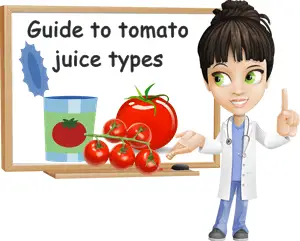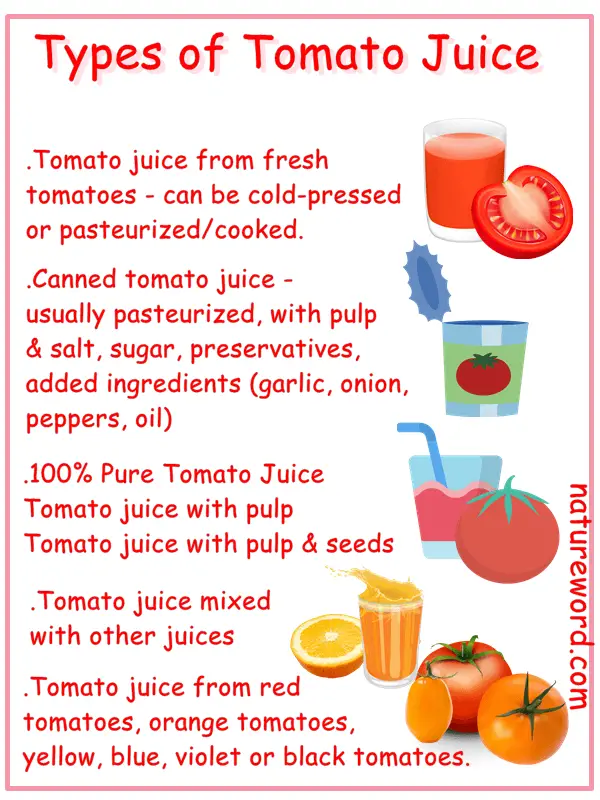Tomato juice is not the same everywhere. You may find there are quite a few options to choose from when it comes to one of the most popular juice varieties that doubles as a fruit and vegetable juice. Aside from the classic canned tomato juice used for cooking, there’s also tomato juice meant to be consumed as a fruit juice, there’s cold pressed and pasteurized and quite a few more types.
1) Commercial canned tomato juice
The most popular variety of tomato juice is canned. Canned tomato juice is a classic option meant for cooking. It may be just juice or predominantly juice with some finely mashed pulp, but no seeds and no peel. Low-cost brands will offer tomato juice made from what is known as tomato puree which is tomato paste reconstituted with water.

Canned tomato juice is almost always pasteurized. It is available in glass jars or bottles, carton boxes and, more rarely, plastic jars or bottles of different sizes.
Expect canned tomato juice to have added salt or sugar, or both, and acidity correctors such as citric acid or calcium chloride.
Other ingredients that may be added to tomato juice include: onion and garlic powder, red and green bell peppers, sweet or spicy paprika, cayenne pepper powder, pureed celery, various herbs such as basil, thyme or rosemary, spices such as ground pepper, glucose syrup, glucose-fructose or high-fructose corn syrup instead of table sugar and vague ingredients listed as spices, natural flavors or color enhancers/additives/dye.
If the tomato juice is organic or the tomatoes used are from organic agriculture or non-GMO, the label will usually say so clearly as an organic, non-GMO food product tends to drive sales higher. A label that says organic or non-GMO builds confidence in the brand, even though it comes with a higher price. The modern consumer is becoming increasingly more educated on food nutrition and displays a growing interest in clean eating so food products labeled organic and/or non-GMO are clearly favored if finances are not an issue.

2) Commercial cold pressed tomato juice
Store bough cold pressed tomato juice is a very popular option meant to be consumed as a dessert rather than used for cooking. It is commonly consumed as a fruit juice, by itself or in combination with other more traditional fruit juices, or used for mocktails, cocktails, lemonade or other refreshing beverages. Different brands may offer different packaging options including glass or plastic bottle or carton package.
The juice is typically without seeds, but there are also options with seeds (rare) and with finely mashed pulp or pulp fiber. This is because the juice is naturally quite watery and pulp or pulp fiber material help thicken it slightly and improve its consistency and mouthfeel.
Cold pressed is always the healthier option because it preserves the vitamins occurring naturally in food. However, unless explicitly written on the label that it’s free of preservatives, additives, acidity correctors and other ingredients commonly added to juice, tomato or other, commercial cold pressed tomato juice may contain all of these ingredients which ultimately render it less healthy than an all-natural option.
It’s also a good idea to check the label to see if it’s 100% pure tomato juice or predominantly tomato juice mixed with secondary juice options. Not that it’s unhealthy, but to make sure you are getting what you want.
3) Home made tomato juice
Vs commercial options, home made tomato juice can be made absolutely fresh, without preservatives or additives. If it’s meant to be consumed in a short amount of time, as a fruit juice for example, it can be made fresh from ripe tomatoes via cold pressing and enjoyed as it is with no added ingredients.
If it’s meant to be used for cooking, for pasta sauces for example, it’s usually cooked (boiled) from fresh, ripe tomatoes and canned in sterilized glass jars. It can be just juice or juice together with finely mashed pulp for a thicker, creamier consistency. While it does not need to have anything added to it, it usually has at least one or two extra ingredients. In order of importance, these include:
- salt for flavor and to improve shelf life (salt is a natural preservative)
- sugar to balance the acidity
- oil such as extravirgin olive oil or sunflower oil (the choice of oil is typically regionally determined with olive oil being the number one choice in Mediterranean regions, while sunflower oil being the go-to option in Balkan countries)
- various herbs for extra flavor: whole basil leaves (unblemished and previously washed and dried) or chopped basil, fresh or dried thyme, rosemary, parsley
- onion, garlic, sweet peppers, either red bell peppers or green bell peppers, cayenne peppers or cayenne pepper powder, sweet or spicy paprika, black peppercorns, bay laurel leaves, sage, mint, dill, coriander etc.
- aspirin added as a preservative for a longer shelf life
The choice of extra ingredients varies according to the recipe used and individual taste.
4) Pure tomato juice (or 100% tomato juice)
Pure tomato juice is usually synonymous with 100% tomato juice. If labeled as such, it should only contain tomato juice without seeds, pulp, pulp fiber or peel, although that is not always the case since tomato pulp or pulp fiber is added for a thicker consistency.
No other fruit or vegetable juices are added and the juice is typically pasteurized, although not always.
However, unless otherwise specified, even pure tomato juice may contain various additives or preservatives, most commonly salt and sugar and acidity correctors such as citric acid or calcium chloride.
While the name sounds good – ‘pure’ tomato juice, ‘100%’ tomato juice – it is not always the exact same thing. It can be fresh tomato juice obtained via cold pressing by juicing fresh, ripe tomatoes. It can be pasteurized tomato juice obtained by cooking fresh and perfectly ripe tomatoes in order to extract the juice. It can be reconstituted tomato juice obtained from either tomato paste reconstituted with water or from tomato concentrate. If store bought, the label should inform consumers of how the juice is obtained.
5) Tomato juice mix
This is a mix of tomato juice with other fruit or vegetable juices such as apple juice, orange juice or carrot, cucumber or celery juice. Flavors vary with country, brand and personal taste (it can be home made).
For the most part, the tomato juice is the main ingredient and the other juices are secondary ingredients. While technically a juice, it may very well contain pulp or pulp fiber for a thicker consistency as pure tomato juice is quite watery.
Sweeteners such as raw honey, sugar or artificial sweeteners, various flavors or herbs may be added to the tomato juice to enhance its taste. The juice may be presented simply as tomato juice, with the other ingredients being listed on the back of the label, or it can be presented as tomato juice with ‘insert name of other juice/s’.
6) Tomato juice with pulp
Tomato juice with pulp is a type of tomato juice with added pulp material or pulp fiber material. It can be store bought or made at home.
The pulp is usually finely mashed and mixed in the juice to make it thicker. The pulp fiber material is also blended inconspicuously to improve the watery consistency of the pure juice.
Tomato juice with pulp can be pasteurized or cold-pressed, with or without seeds, and may or may not contain other ingredients or additives.
If home-made, it can be just tomato juice, but if store bought, it will most likely contain preservatives, flavor additives, acidity correctors etc.
7) Tomato juice with seeds
This is another option, albeit not very popular since the seeds give the juice a less pleasant texture, contrasting with the fine consistency of the plain juice. Tomato juice with seeds is commonly home-made and may or may not contain pulp material as well. It is nonetheless quite a healthy option, especially if it’s cold-pressed, because the seeds are an important source of dietary fiber and also contain essential vitamins such as vitamin E.
8) Pure tomato juice without seeds, pulp or peel
If the tomato juice is actual tomato juice obtained by pressing or cooking fresh, ripe tomatoes and does not have seeds, peels, pulp or pulp fiber material added to it, or additives, then it’s 100% pure tomato juice.
Its consistency should be more watery, its flavor should have a slightly diluted taste, and its color should not be extremely intense, but rather a moderately vibrant orangey-red or pink-red color instead of the dye-red typical of tomato paste.
It can be cold-pressed, in which case it has a sweeter and only slightly piquant taste with fresh tomato flavors. If it’s filtered, it’s quite smooth, but it can also be unfiltered in which case a foam is usually present on top. It can also be pasteurized in which case the color is deeper and the taste more like cooked tomato, with somewhat stronger acidity (unless counteracted with added sugar or acidity correctors).
9) Sweet and spicy tomato juice
While sweet tomato juice is the most popular option, spicy options are also commonly available. Sweet tomato juice is made with tomatoes and ingredients that are not spicy (but may contain garlic and onions and ground pepper or peppercorns for flavor) while spicy tomato juice contains spicy paprika from hot peppers, cayenne pepper powder and other ingredients that give it a measurable hot taste. It can be home-made too.
10) Different tomato juice colors
About 99% of the time, tomato juice is red, albeit different shades depending on how it’s been processed. But there are also specialty tomato juices such as yellow tomato juice and orange tomato juice. Technically you can make juice from all tomato colors, including blue tomatoes, violet, red-purple and black tomatoes.
However, the higher price range of these other tomato colors makes for a higher end juice that is simply not very commercially desirable right now. But that doesn’t mean that such juices don’t exist or that you can’t make black tomato juice yourself at home.
